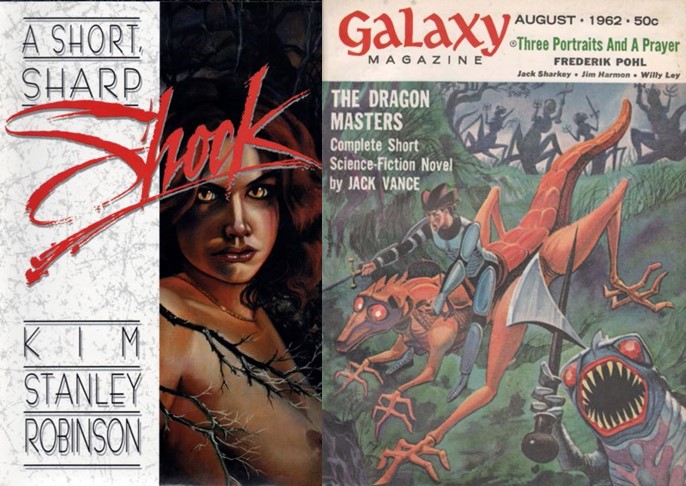Tor Doubles #28: Kim Stanley Robinson’s A Short, Sharp Shock and Jack Vance’s The Dragon Masters

Originally published in December 1990, Tor Double #28 contains the fourth story (but third headlining story) by Kim Stanley Robinson, who first appeared in Tor Double #1, and the second, and final story by Jack Vance.
The Dragon Masters was originally published in Galaxy in August 1962. It was previously published as part of an Ace Double (with Vance’s The Five Gold Bands) by Ace Books in 1963. It won the Hugo Award and the Seiun Award.
Just as Vance’s earlier story in the Tor Doubles series, The Last Castle, used fantasy tropes to tell a science fiction story, reading The Dragon Masters also feels like reading a fantasy story despite the clear science fictional elements and rationales.
Vance has created Aerlith, a world with a relatively small human population, with a focus on Joaz Banbeck, who governs Banbeck Vale, and Ervis Carcolo, the leader of the rival Happy Valley. Their families have had a generations long battle and in this generation it is clear that while Carcolo is intent on taking over Banbeck Vale, it is equally clear that logistically, strategically, and tactically, he isn’t up to the task, something his general, Bast Givven, tried to convince him of while not running afoul of Carcolo’s temper.
The main forces each man governs are not humans, but rather genetically modified reptilian creatures, the dragons of the title. Each type of dragon has its own strengths and weaknesses, which Carcolo and Banbeck are well aware of and their thinking takes those into account, much as a general knows the strengths and weaknesses of different tanks or aircraft his forces use.
As the story progresses, switching between Carcolo and Banbeck’s viewpoint, Vance builds up his world, with Carcolo focusing on his military and Banbeck providing the historical understanding of the world as well as a more holistic view of the universe in which they live.
In addition to the humans and dragons on Aerlith, the planet is also populated by the mysterious sacerdotes, who appear like naked humans with long hair who have their own agenda and don’t interact with the humans, even when they come into contact with them. In addition, human culture on Aerlith is aware that they originally came from other worlds and the humans of Banbeck Vale and Happy Valley have been abandoned by the space-faring humans.
Banbeck is concerned that the nearing of a red star presages an attack on the humans of Aerlith by the “Basics,” which he believes will be a catastrophic event. When he suggest that Carcolo make common case with him against the grephs, or “Basics,” Carcolo scoffs at the idea, viewing Banbeck’s concerns as baseless. By the time events would provide that Banbeck was a latter-day Cassandra, Carcolo had already burned his bridges with Banbeck, who, in one of his few major errors, refused to combine forces with Carcolo.
Carcolo’s short-sightedness and his need to view himself as a conqueror despite all evidence to the contrary, leads him into disaster, which he blames on everyone except himself. Vance depicts him as a narcissist who is unable to deal with any reality that contradicts the way he believes the world should work, while at the same time he overestimates his own abilities. Vance does an excellent job of showing Givven playing a yes-man to Carcolo while at the same time demonstrating that Givven knows the reality of the situation on the ground.
The title of the story is misleading, as it conjures up images of a story about great wyrms rather than the types of dragons that Carcolo and Banbeck are masters of. Furthermore, they eventually discover that the situation in space is a reversal of the situation on Aerlith, with enslaved and modified humans serving as the shock troops for the Basics, leading to battles between the enslaved humans and the modified dragons as Carcolo and Banbeck, separately, try to fend off the invaders and maintain some form of the status quo, even seeking assistance from the sacerdotes.
In the end, the status quo doesn’t hold, but it isn’t completely destroyed. The coming of the Basics served as a warning to the humans of Aerlith who now have a better understanding of their place in the universe and the motivation to improve their place in the universe and look beyond Banbeck Vale and Happy Valley.

Isaac Asimov’s Science Fiction Magazine May 1990 cover by Gary Freeman
A Short, Sharp Shock was originally published as a chapbook by Mark V. Zeising Press in May 1990. It was nominated for the Hugo Award and won the Locus poll.
One of the cliché tropes in science fiction is the character who wakes up without any knowledge of who they are or anything about the world in which they live. This allows the author to provide that information to both the character and the reader slowly, to allow the reader to come to understand a strange world that differs from our own. Kim Stanley Robinson makes use of this trope in A Short, Sharp Shock, in which Thel’s first awareness in drowning in an ocean alongside a woman who is only referred to as “the swimmer” throughout the novel.
They are rescued, but quickly separated, with the swimmer taken captive by the “Spine Kings,” who will apparently enslave of kill her. Thel is found by more friendly people who help guide him along the mountainous peninsula which appears to circle the world, water on either side, as they move through the mountains, searching for the spine kings so they can rescue the swimmer. The aspect of Thel walking along a narrow, apparently world-spanning mountainous pathway with water on either side of him is reminiscent of The Death of Doctor Island, published only three volumes earlier, although, of course, Thel’s adventures do not mirror Nicky’s in any way.
Readers looking for plot will be disappointed in A Short Sharp Shock, as Thel and his companions move along the mountain, trying to learn more about the world they live in and how who they are. At time, it seems like Thel’s journey is an extended metaphor for life. He comes into the world from a wet place, not knowing anything about the world or who he is. He finds people who are willing to teach and nurture him. He slowly learns about the world, meeting different people, some of whom are helpful, others not, and some who seem to help him, but really harm him. He must overcome obstacles and eventually may find love.
In the course of his travels, Thel comes into possession of a mirror through which he case pass, always returning to the world of the peninsula, although changed, as if the mirror represents him passing from one stage of life to another.
Over the course of the story, Thel encounters several individuals whose existence seems almost surreal, from the tree folk, who have fruit trees growing from their shoulders and can produce sustenance for Thel, or the facewomen, who have a series of smaller heads growing out of their eye sockets. The fact that Robinson complete fails to acknowledge the surreal nature of Thel’s companions. In fact, the only real in-story references to the world’s oddity is Thel questioning how the world, with its planet-girding peninsula could exist, a point Thel raises multiple times.
Thel receive multiple answers about the cosmogony of his world, each from a different group of people he encounters. Although each of his respondents fully believes what they tell him, it is clear that all of the explanations for the creation of this world are mythic in nature, none of them representing a scientific truth, but merely a story that attempts to get at a greater “truth.”
Throughout the story, Thel is focused on the swimmer, a woman he knows nothing about except that they were both in the water at the same time and that she was apparently taken by the spine kings. Even when they reconnect, she remains a mysterious figure, never given a name, but someone who is inexplicably important to Thel, representing the mate people search for and potentially discover.
The story ends with Thel once again stepping through the mirror he carries, perhaps a way of going back to the life which it is hinted he lived before finding his way to the world of the peninsula, but also possibly a metaphor for death, as he leaves the struggles and people of the peninsula behind for a grand adventure into the unknown.
A Short, Sharp Shock may be the most metaphorical story in the Tor Double series. While other stories are metaphorical or psychological in nature, most of them also have a grounding in plot and a connection to our world. The story which comes closest to this one is Wolfe’s aforementioned The Death of Doctor Island and the two would have made an interesting themed volumes if published together, although the nature of the works may have turned off readers who wanted stories which relied more on traditional plotting and characterization.
Brad Teare provided the cover.
 Steven H Silver is a twenty-one-time Hugo Award nominee and was the publisher of the Hugo-nominated fanzine Argentus as well as the editor and publisher of ISFiC Press for eight years. He has also edited books for DAW, NESFA Press, and ZNB. His most recent anthology is Alternate Peace and his novel After Hastings was published in 2020. Steven has chaired the first Midwest Construction, Windycon three times, and the SFWA Nebula Conference numerous times. He was programming chair for Chicon 2000 and Vice Chair of Chicon 7.
Steven H Silver is a twenty-one-time Hugo Award nominee and was the publisher of the Hugo-nominated fanzine Argentus as well as the editor and publisher of ISFiC Press for eight years. He has also edited books for DAW, NESFA Press, and ZNB. His most recent anthology is Alternate Peace and his novel After Hastings was published in 2020. Steven has chaired the first Midwest Construction, Windycon three times, and the SFWA Nebula Conference numerous times. He was programming chair for Chicon 2000 and Vice Chair of Chicon 7.
The title of Robinson’s story comes from the end of a song in Gilbert & Sullivan’s “The Mikado” where Pooh-Bah, Pish-Tush, and Ko-Ko explain that they don’t want to be executed. The lyrics and music of this section are a rapid-fire patter totally different from everything previous in the song, and build to one of the most grandiloquent song endings in the Savoy repertoire, such that the intricate rhymes, alliteration and grand music obscure the grotesque and disturbing imagery of the lyrics:
I don’t much care, So I object — I must decline —
To sit in solemn silence in a dull, dark dock,
In a pestilential prison, with a life-long lock,
Awaiting the sensation of a short, sharp shock,
From a cheap and chippy chopper on a big black block!
To sit in solemn silence in a dull, dark dock,
In a pestilential prison, with a life-long lock,
Awaiting the sensation of a short, sharp shock,
From a cheap and chippy chopper on a big black block!
A dull, dark dock, a life-long lock,
A short, sharp shock, a big black block!
To sit in solemn silence in a pestilential prison,
And awaiting the sensation
From a cheap and chippy chopper on a big black block!
I remember reading The Dragon Masters a million years ago. Great book.